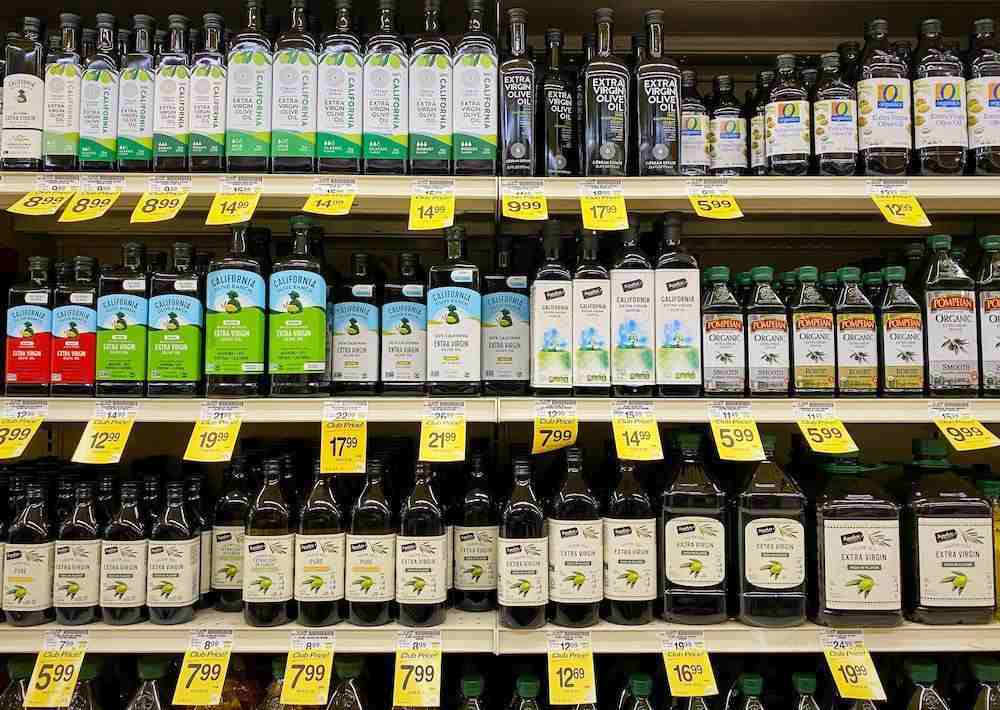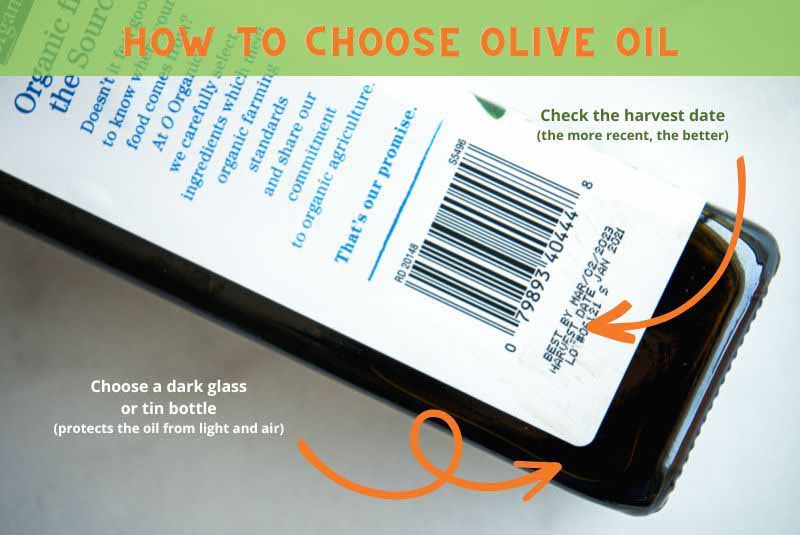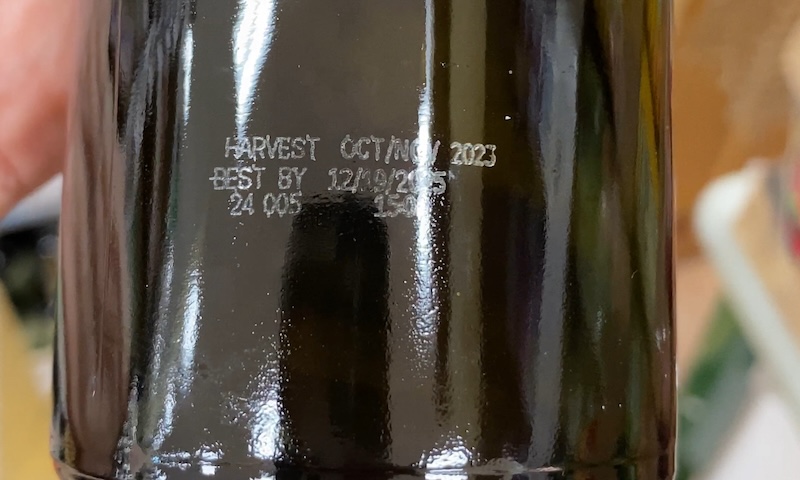When you need to buy olive oil, the choices can seem overwhelming. Here are two steps to help you find the best next time you’re at the supermarket.

Seriously — how are you supposed to choose from all this when you need to buy olive oil?
The other week I stood in front of the wall of olive oil at the supermarket. Options ran the gamut from pretty cheap to quite expensive. Which to choose?
Within 30 seconds and two steps, I zeroed in on a well-priced bottle of Pavilions’ own O Organic California extra-virgin olive oil made from fruit harvested less than six months earlier. I danced a little jig. (Yes, I need to get out more.) Here are two super-simple tips to find the best option wherever you’re shopping:
1. Buy Olive Oil In the Right Container
First, I scan the packaging and skip over anything in clear or plastic bottles.
Clear bottles expose delicate oil to damaging light, and plastic is a permeable material that exposes it to air. Light and air will make your oil age faster.
This whittles down the choices – a lot.
Instead, I look for oil packaged in tin or dark glass, both of which help protect it from light and air.
For extra credit, I skip bottles on the top shelf, as those have been exposed to the most light. I even pull a bottle from the back of the shelf, where it’s sitting in the dark.
You may also spot bag-in-box oil, which is a newer packaging technology. Similar to boxed wine, the oil is packed in a plastic bag that shrinks as the oil is used, which minimizes its exposure to air and extends the shelf life significantly. This is a nice option to buy olive oil.

Salty Condiments, From Soy Sauce to Worcestershire >>
2. The Freshest Olive Oil
Fresh oil smells and tastes glorious — herbal, grassy, peppery, even fruity. After all, olives are fruit. The fresher the oil, the better it tastes.
But when you’re at the supermarket and don’t have the luxury of opening a bottle to sniff and taste it, how can you gauge its freshness?
When I find a bottle that looks promising, I check the label for a harvest date – ideally one within the last 12 months.
More brands now include this info, which makes it easier to buy olive oil. Manufacturers like California Olive Ranch, which you’ll find at many big-box stores, as well as many smaller producers proudly include a harvest date on their labels. So do some private-label brands.
Some will note the year olives were harvested. If they include the month, even better. You can see why I was so excited about that jackpot bottle I found the other week.
UPDATE January 2024: Last month I spied California extra-virgin olive oil at Trader Joe’s with an Oct/Nov 2023 harvest date stamped on the bottle. You’d have to be a knowledgeable shopper really examining the bottle to see it, but it’s there!

Sometimes you have to look really closely to see if there’s a harvest date on an olive oil bottle.
“Best by” or “best before” dates are far more common, but much less reliable. Depending on the producer, that “best by” date can be two years — sometimes even longer — after the harvest date. If you only find bottles with a “best by” or “best before” date, choose one with a date as far in the future as possible.
Is supermarket olive oil going to be great? Probably not, but the options are improving. You’re more likely to at least find some that’s reasonably fresh.
What about buying olive oil online? That’s a little trickier. You probably can tell whether it’s packaged in dark glass or tin from the product images. And look for sellers who specify the harvest year in their product description. Include “olive oil 2023 harvest” (or the most recent harvest year) in your search, and you’ll be served lots of delicious options.
Bonus Tips
Those two steps will help you find good options, but the labels offer a lot of other helpful information when choosing oil — if you know what to look for.
- Extra virgin: You’ll often see “first cold pressed” on the label, but for oil to qualify as “extra virgin,” it must also pass strict chemical and specific sensory standards. If it’s certified by the International Olive Council (IOC) or California Olive Oil Council (COOC), you know it meets minimum requirements for low acidity and is free of flavor defects. This is an unrefined form of olive oil.
- Virgin: This oil is considered lower quality than extra-virgin olive oil because it has slightly higher acidity. It’s also unrefined and perfectly good to use.
- Pure: This isn’t “pure” at all, though UC Davis research found nearly half of consumers think it’s the highest-quality stuff on the market. In fact, it’s a blend of a little bit of virgin olive oil and a lot of highly refined (often with chemical solvents) oil made from olive pomace or “mash” leftover from producing virgin olive oil.
- Light, lite or extra-light: This sounds like a healthy choice, right? “Light” refers to the oil’s neutral color and flavor. In terms of calories and fat, it’s the same as other olive oils. It may also be mixed with other types of oil.
- “Made in Italy,” “bottled in Italy,” “imported from Italy.” Italy produces some of the world’s most glorious olive oil. It also exports some of the world’s worst. If you see terms like this on a label, check the ingredient list, which must include the true country — or countries — of origin. Also consider that while countries like Spain, Greece and Tunisia produce incredible olive oil, they’re not selling their best stuff to be bottled and exported as “Italian.”
What about blends? Many producers will use oils from a variety of olives (which should always be from the same harvest year) to achieve a balanced flavor profile; others may opt a single-variety oil. It’s a matter of your flavor preference.
Deep Freeze: Frozen Food Is Cool Again >>
Choose the Right Oil for Your Needs
It’s a myth that you shouldn’t use extra-virgin olive oil for cooking. Extra-virgin olive oil has a smoke point of up to 410° F, making it a fine choice for cooking, even frying.
Unfiltered extra-virgin olive oil is considered an artisanal product, and therefore more expensive. All that cloudiness and particulate matter adds flavor and character. Unfiltered oil also tends to be higher in antioxidant polyphenols. Buy fancy unfiltered EVOO in small amounts and use it in dressing or as a condiment, drizzled over soup or beans or roasted vegetables.
An oil’s color is a sign of the type of olive used and when it was harvested (early-season oils may to be greener). Robust olio nuovo, made with young, first-of-season olives, tends to have a pungent, peppery, even bitter bite (also an indication of more antioxidants).
Mellow-tasting oil, produced later in the season when the fruit is riper. I love it for baking. Frankly, that Trader Joe’s example I cite above, which is very mild-tasting, would be very nice for baking.
Buy Only What You’ll Use
A large tin of olive oil might seem like a good bargain, but it’s a false economy if you won’t use it up in promptly. Even top-quality extra-virgin oil will taste rancid when it oxidizes with age (all oil oxidizes, eventually). Remember, as you use it, more air is introduced into the bottle or tin. (A larger container of bag-in-box oil, however, will hold up longer.)
Instead, opt for a smaller container that you’ll use up quickly — ideally in less than two months. That’s especially true if you’re buying a high-end unfiltered extra-virgin olive oil to use as a condiment.
Handle with Care
Once you get that beautiful oil home, treat it properly so it doesn’t spoil. And that means keeping it in your pantry or cupboard, away from light and heat. And keep it sealed to minimize oxidation.
I’ve had some chefs recommend stashing oil in the fridge to extend its shelf life. But Nancy Ash, president of Strictly Olive Oil, a company that specializes in olive oil quality assessments, isn’t a fan. “Although the cold will slow down oxidation, when [the oil] warms to room temperature you will notice condensation near the top of the bottle,” she explains. “Those water droplets then mix with the oil and promote oxidation.
“It’s best just to use it up before it oxidizes,” she adds.
Also, never keep olive oil by the stove, where heat can cause it to oxidize more quickly.
(There’s a trend going around on TikTok featuring a slim shelf that can be set atop the back of a stove. While I understand the need to maximize space in a small kitchen, this is a terrible place to put olive oil — or any oil, for that matter. First, the proximity to the stove’s heat will make your oil go rancid more quickly. Second, oil is flammable! This is an especially risky setup if you have gas burners. Please, just don’t.)
Most importantly, use it! Unlike wine, olive oil doesn’t improve with age.
3 Amazing Oils to Try
You won’t find these at the supermarket, but they’re definitely worth ordering directly from the producers:
Fat Gold. This is a super-small Bay Area producer. You can purchase individual tins or subscribe for shipments four times a year. I’ve subscribed since they first launched and getting these every few months is a huge treat.
Seka Hills. The Yocha Dehe Wintun Nation in California’s Capay Valley produces fantastic oils (along with honey, beer, wine and other goodies).
Round Pond Estate. This Napa Valley vineyard also produces terrific olive oil. Their blood orange and Meyer lemon varieties are two of my favorites.
